|
|
|
|
Analytic geometry
- Conic sections
|
|
|
|
Parabola
|
|
Definition and construction
of the parabola
|
|
By intersecting
either of the two right circular conical surfaces (nappes) with the plane parallel to any generator of the cones, then the intersection curve is
the parabola. |
| A parabola is the set of all points in a plane that are the same distance from a point F, called the focus, and a
line d, called the
directrix. |
|
A parabola is uniquely determined by the distance of
the focus from the directrix.
|
|
This distance is called the
focal parameter
p
and its midpoint A is the vertex
(apex) of the parabola.
|
|
The parabola has an axis of symmetry which passes
through the
focus perpendicular to the directrix.
|
|
The distance of any point
P
of the parabola from the directrix and from the focus is denoted r, so
|
| d(Pd
P) =
FP =
r.
|
| Construction of the parabola
|
|
To a given parameter
p
of the parabola draw corresponding directrix d
and the focus F.
|
|
To the distances greater then
p/2
draw lines, of arbitrary dense, parallel to the
directrix.
|
|
Then, intersect each line at two
symmetric points by arc centered at the focus with a radius
which equals the distance of that line from the
directrix.
|
|
The distance
p/2
from the vertex A
to the directrix or focus is called focal
distance.
|
|
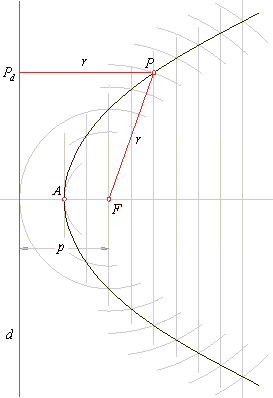 |
|
|
|
Vertex form of the equation of a parabola
|
|
If a parabola is placed so that its vertex coincides with the origin of the coordinate system and its axis lies along the x-axis then for every point of the parabola
|
|
|
|
shows that to
every positive value of x
correspond two opposite values of y
which are symmetric relative to the x-axis.
|
|
|
The parabola
y2 =
2px,
p >
0
|
| is not defined for
x <
0, it opens to
the right.
|
| For x
= p/2
the
corresponding ordinate
y = ± p.
|
| This parabola is not a function since the vertical line crosses
the graph more than once.
|
| A focal chord is a line segment passing through the
focus with endpoints on the curve.
|
| The latus rectum is the focal chord
(P1P2
=
2p)
perpendicular
to the axis of the parabola.
|
| Therefore, we can easily sketch the graph of the
parabola using following points, |
| A(0,
0), P1,2(p/2,
±
p) and P3,4(2p,
±2p)
|
|
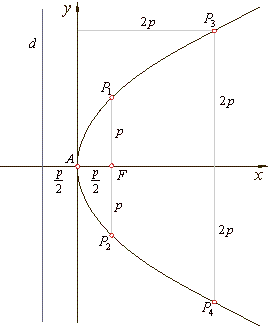 |
|
|
Transformation of the equation of a parabola
|
|
The equation
y2 = 2px,
p < 0
represents the parabola opens to the left since must be y2
> 0. Its axis of
symmetry is the x-axis.
|
|
If variables
x and
y change the role obtained is the parabola whose axis of
symmetry is y-axis.
|
|
For
p >
0
the parabola opens up, if
p <
0
the parabola opens down as shows
the below figure.
|
 |
|
This parabola we often write
y = ax2,
where
a = 1/(2p) , with the focus at
F(0,
1/(4a)) and the directrix
y =
-1/(4a).
This parabola is a function since a vertical line crosses its graph at only one point.
|
|
|
Equation of a translated parabola - the standard form
|
|
By parallel shifting of the parabola
y2 = 2px in the direction of the coordinate axes the vertex of the parabola
can be brought at a point A(x0, y0) while coordinates
x
and y of every point of the parabola |
|
changes by the value of the
translations x0 and
y0, so that equation of the translated
parabola is
|
| (y
-
y0)2 = 2p(x
-
x0) |
|
If p >
0
the parabola
opens to the right and if p
< 0 the parabola opens to the left.
|
|
If the focal parameter
p = 2a
then the above equation
|
|
becomes, (y
-
y0)2 =
4a(x
-
x0).
|
|
The translated parabola with the axis parallel to the
x-axis can also be written as
|
| x =
ay2
+ by
+ c.
|
|
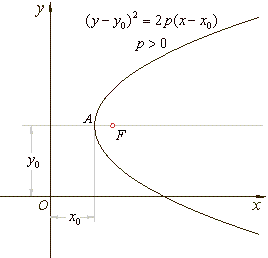 |
|
|
|
The parabola whose axis of symmetry is parallel to the y-axis
|
|
By translating the parabola
x2 = 2py
its vertex is moved from the origin to the point A(x0, y0)
so that its equation transforms to
|
|
(x
-
x0)2 = 2p(y
-
y0).
|
|
The axis of symmetry of this parabola is parallel to the
y-axis.
This parabola is a function that we usually
write
|
|
y = ax2
+ bx + c
or y
-
y0 =
a(x
-
x0)2,
|
| where |
 |
|
|
This parabola opens up
|
|
if
a >
0
and opens down if
a < 0.
|
|
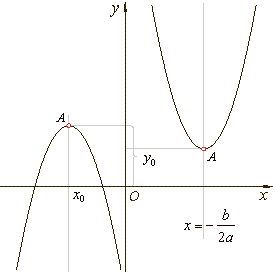 |
|
|
Equations of the parabola written in the general form
|
| a) the axis of the parabola parallel to the
x-axis
|
b) the axis of the parabola parallel to the
y-axis |
|
Ay2
+ Bx + Cy +
D =
0, A and
B
are
not
zero, |
Ax2
+ Bx + Cy +
D =
0, A and
C
are
not
zero |
|
or x =
ay2
+ by
+ c,
a
is
not
zero. |
or
y =
ax2
+ bx
+ c,
a
is
not
zero. |
|
| Note
that the parabola has equation that contains only one squared term. |
|
|
Parametric equations of the parabola
|
|
Parametric equations of the parabola
y2 =
4ax
with the vertex A
at the origin and the focus F(a,
0), and of its translation (y
-
y0)2 =
4a(x
-
x0)
with the vertex A(x0, y0)
and the focus F(x0
+ a, y0)
written
|
| respectively
are, |
 |
|
 |
|
|
|
Parametric equations of the parabola
x2 =
4ay
with the vertex A
at the origin and the focus F(0,
a), and of its translation
(x
-
x0)2 =
4a(y
-
y0)
with the vertex A(x0, y0)
and the focus F(y0,
y0
+ a) written
|
| respectively
are, |
 |
|
 |
|
|
|
|
Example:
Write equation of the parabola
y2 = 2px
passing through the point P(-4,
4) and find the focus,
the equation of the directrix and draw its graph.
|
|
Solution: The coordinates of the point P
must satisfy the equation of the parabola
|
|
P(-4,
4)
=>
y2 =
2px
|
|
42 = 2p(-4)
=> p =
-2
|
|
thus, the
equation of the parabola y2 =
-4x.
|
|
The coordinate
of the focus,
|
| since
F(p/2,
0)
then F(-1,
0).
|
|
The equation of the directrix,
as x =
- p/2, x =
1.
|
|
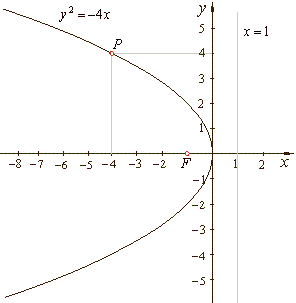 |
|
|
Example:
Find the vertex, the focus and the equation of the directrix and draw the graph of the parabola
y =
-x2
+ 6x -
7.
|
|
Solution: Rewrite
the equation of the parabola in the translatable form
|
| (x
-
x0)2 = 2p(y
-
y0) or
y
-
y0 = a(x
-
x0)2
|
|
so, y =
-x2
+ 6x -
7
=> y =
-(x2
-
6x) -
7
|
|
y =
-[(x
-
3)2
-
9] -
7
|
| y
-
y0 = a(x
-
x0)2,
y
-
2 = -(x
-
3)2,
a
= -1.
|
|
The vertex of the parabola
A(x0, y0),
or
A(3, 2).
|
|
he focus
F(x0,
y0 + 1/(4a)),
or
F(3,
7/4).
|
|
The equation of the directrix,
|
|
y =
y0 -
1/(4a),
y = 2 +
1/4 or
y =
9/4.
|
|
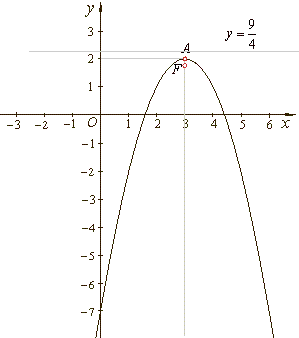 |
|
|
|
|
|
|
|
|
|
|
|
|
|
|
|
|
|
|
|
|
|
|
|
|
|
|
|
|
Contents
D
|
|
|
|
|

|
|
|
|
|
|
Copyright
© 2004 - 2020, Nabla Ltd. All rights reserved.
|
|
|